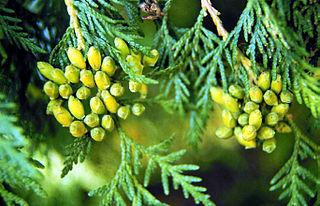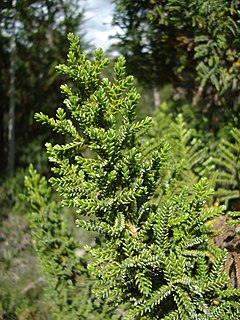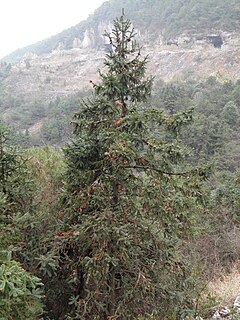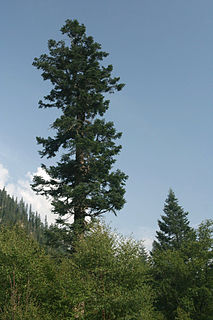
Thuja is a genus of coniferous trees in the Cupressaceae. There are five species in the genus, two native to North America and three native to eastern Asia. The genus is monophyletic and sister to Thujopsis. Members are commonly known as arborvitaes, thujas or cedars.

Cupressaceae is a conifer family, the cypress family, with worldwide distribution. The family includes 27–30 genera, which include the junipers and redwoods, with about 130–140 species in total. They are monoecious, subdioecious or (rarely) dioecious trees and shrubs up to 116 m (381 ft) tall. The bark of mature trees is commonly orange- to red- brown and of stringy texture, often flaking or peeling in vertical strips, but smooth, scaly or hard and square-cracked in some species.

Thuja occidentalis, also known as northern white cedar, eastern white cedar, or arborvitae, is an evergreen coniferous tree, in the cypress family Cupressaceae, which is native to eastern Canada and much of the northcentral and northeastern United States. It is widely cultivated as an ornamental plant.

Platycladus is a monotypic genus of evergreen coniferous trees in the cypress family Cupressaceae, containing only one species, Platycladus orientalis, also known as Chinese thuja, Oriental arborvitae, Chinese arborvitae, biota or Oriental thuja. It is native to northeastern parts of East Asia and North Asia, but is also now naturalised as an introduced species in other regions of the Asian continent.

Calocedrus, the incense cedar, is a genus of coniferous trees in the cypress family Cupressaceae first described as a genus in 1873. It is native to eastern Asia and western North America. The generic name Calocedrus means "beautiful cedar".

Pilgerodendron is a genus of conifer belonging to the cypress family Cupressaceae. It has only one species, Pilgerodendron uviferum, which is endemic to the Valdivian temperate rain forests and Magellanic subpolar forests of southern Chile and southwestern Argentina. It grows from 40 to 55°S in Tierra del Fuego, where it is the southernmost conifer in the world. It is a member of subfamily Callitroideae, a group of distinct Southern Hemisphere genera associated with the Antarctic flora.

Taiwania, with the single living species Taiwania cryptomerioides, is a large coniferous tree in the cypress family Cupressaceae.

Cunninghamia is a genus of one or two living species of evergreen coniferous trees in the cypress family Cupressaceae. They are native to China, northern Vietnam and Laos, and perhaps also Cambodia. They may reach 50 m (160 ft) in height. In vernacular use, it is most often known as Cunninghamia, but is also sometimes called "China-fir". The genus name Cunninghamia honours Dr. James Cunningham, a British doctor who introduced this species into cultivation in 1702 and botanist Allan Cunningham.

Thuja standishii is a species of thuja, an evergreen coniferous tree in the cypress family Cupressaceae. It is native to southern Japan, where it occurs on the islands of Honshū and Shikoku. It is a medium-sized tree, reaching 20–35 m tall and with a trunk up to 1 m diameter.

Glyptostrobus pensilis, known in Chinese as 水松, and also Chinese swamp cypress, is the sole living species in the genus Glyptostrobus. It is native to subtropical southeastern China, from Fujian west to southeast Yunnan, and also very locally in northern Vietnam and Laos.

Tetraclinis is a genus of evergreen coniferous trees in the cypress family Cupressaceae, containing only one species, Tetraclinis articulata, also known as Thuja articulata, sandarac, sandarac tree or Barbary thuja, endemic to the western Mediterranean region. It is native to northwestern Africa in the Atlas Mountains of Morocco, Algeria, and Tunisia, with two small outlying populations on Malta, and near Cartagena in southeast Spain. It grows at relatively low altitudes in a hot, dry subtropical Mediterranean climate.

Juniperus squamata, the flaky juniper or Himalayan juniper, is a species of coniferous shrub in the cypress family Cupressaceae, native to the Himalayas and China

Cupressus funebris, the Chinese weeping cypress, is a species of cypress native to southwestern and central China. It may also occur naturally in Vietnam.

Juniperus foetidissima, with common names foetid juniper or stinking juniper, is a juniper tree species in the family Cupressaceae.

Callitris columellaris is a species of coniferous tree in the family Cupressaceae, native to most of Australia. Common names include White Cypress-pine, Murray River Cypress-pine, and Northern Cypress-pine. Callitris columellaris has become naturalised in Hawaii and in southern Florida.

Calocedrus formosana is a conifer endemic to Taiwan.

Calocedrus macrolepis is a conifer native to southwest China, northern Vietnam, northern Laos, extreme northern Thailand and northeastern Myanmar.

Abies fargesii is a species of fir, a coniferous tree in the family Pinaceae. Its common name is Farges' fir, after the French missionary, botanist and plant collector, Paul Guillaume Farges. Abies fargesii can grow very large and be up to 40 metres (130 ft) tall. It is endemic to central China where it is found in Gansu, Henan, Hubei, Shaanxi, and Sichuan provinces. It grows in mountains and river basins at altitudes between 1,500–3,900 metres (4,900–12,800 ft) ASL. The cones of the given fir are 0.8 to 1.5 by 1.3–2 centimetres (0.51–0.79 in).
Juniperus convallium is a species of conifer in the family Cupressaceae. It is a tree that is found only in the mountains of the Chinese provinces of; Tibet, Qinghai, and Sichuan.

Thuja koraiensis, also called Korean arborvitae, is a species of Thuja, native to Korea and the extreme northeast of China (Changbaishan). Its current status is poorly known; the small population in China is protected in the Changbaishan Nature Reserve, as is the small population in Soraksan Nature Reserve in northern South Korea, but most of the species' range in North Korea is unprotected and threatened by habitat loss.


















